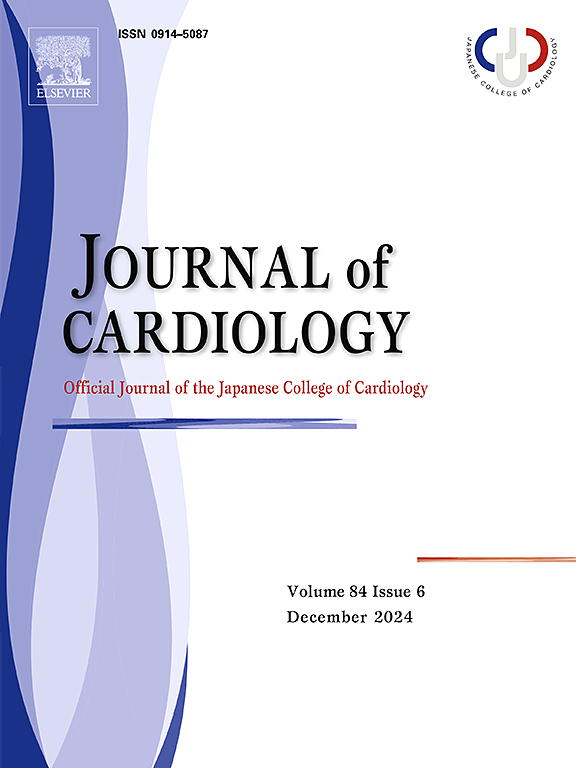Benefit of prehospital electrocardiogram on door-to-device time in ST-segment elevation myocardial infarction with cardiogenic shock: Data from the Kanagawa Acute Cardiovascular Registry
IF 2.5
3区 医学
Q2 CARDIAC & CARDIOVASCULAR SYSTEMS
引用次数: 0
Abstract
Background
The benefit of prehospital 12‑lead electrocardiogram (PH-ECG) performed by emergency medical service personnel at the site of first medical contact (FMC) in patients with ST-segment elevation myocardial infarction (STEMI) with cardiogenic shock (CS-STEMI) remains unclear. This study aimed to investigate the effect of PH-ECG on door-to-device time in patients with CS-STEMI.
Methods
This study enrolled CS-STEMI (Killip class IV) patients who were transferred directly to hospitals by ambulance (n = 517) from the Kanagawa Acute Cardiovascular Registry database. Patients were divided into PH-ECG (+) (n = 270) and PH-ECG (−) (n = 247) groups. Patients who experienced out-of-hospital cardiac arrest, who did not undergo emergent coronary intervention, or whose data were missing were excluded. Patient characteristics, FMC-to-door time, door-to-device time, and in-hospital mortality were compared between the groups.
Results
The patient backgrounds of the PH-ECG (+) and PH-ECG (−) groups were comparable. The peak creatinine kinase level was greater in the PH-ECG (+) group than in the PH-ECG (−) group [2756 (1292–6009) IU/ml vs. 2270 (957–5258) IU/ml, p = 0.048]. The FMC-to-door time was similar between the two groups [25 (20−33) min vs. 27 (20–35) min, p = 0.530], while the door-to-device time was significantly shorter in the PH-ECG group [74 (52–103) min vs. 83 (62–111) min, p = 0.007]. In-hospital mortality did not differ between the two groups (18 % vs. 21 %, p = 0.405). Multivariable logistic regression analyses revealed that PH-ECG (+) was independently associated with a door-to-device time < 60 min [odds ratio (95 % confidence intervals): 1.88 (1.24–2.83), p = 0.003].
Conclusions
PH-ECG was significantly associated with shorter door-to-device times in patients with CS-STEMI. Further studies with larger populations and more defined protocols are required to evaluate the utility of PH-ECG in patients with CS-STEMI.

院前心电图对 ST 段抬高型心肌梗死伴心源性休克患者的门到设备时间的益处:神奈川急性心血管病登记数据。
背景:对于ST段抬高型心肌梗死(STEMI)伴心源性休克(CS-STEMI)患者,急救人员在首次医疗接触(FMC)现场进行院前12导联心电图(PH-ECG)的益处尚不明确。本研究旨在探讨PH-ECG对CS-STEMI患者门到设备时间的影响:本研究从神奈川县急性心血管登记数据库中选取了由救护车直接转入医院的 CS-STEMI(Killip 分级 IV)患者(n = 517)。患者被分为 PH-ECG (+) 组(270 人)和 PH-ECG (-) 组(247 人)。院外心脏骤停、未接受紧急冠状动脉介入治疗或数据缺失的患者被排除在外。比较了两组患者的特征、FMC到门时间、门到设备时间和院内死亡率:结果:PH-ECG(+)组与PH-ECG(-)组的患者背景相当。PH-ECG(+)组的肌酸激酶峰值高于PH-ECG(-)组[2756 (1292-6009) IU/ml vs. 2270 (957-5258) IU/ml,P = 0.048]。两组的 FMC 到门时间相似 [25 (20-33) min vs. 27 (20-35) min, p = 0.530],而 PH-ECG 组的门到设备时间明显更短 [74 (52-103) min vs. 83 (62-111) min, p = 0.007]。两组的院内死亡率没有差异(18% 对 21%,P = 0.405)。多变量逻辑回归分析显示,PH-ECG(+)与门到设备时间结论独立相关:PH-ECG与CS-STEMI患者更短的门到设备时间明显相关。要评估PH-ECG在CS-STEMI患者中的效用,还需要对更大的人群和更明确的方案进行进一步研究。
本文章由计算机程序翻译,如有差异,请以英文原文为准。
求助全文
约1分钟内获得全文
求助全文
来源期刊

Journal of cardiology
CARDIAC & CARDIOVASCULAR SYSTEMS-
CiteScore
4.90
自引率
8.00%
发文量
202
审稿时长
29 days
期刊介绍:
The official journal of the Japanese College of Cardiology is an international, English language, peer-reviewed journal publishing the latest findings in cardiovascular medicine. Journal of Cardiology (JC) aims to publish the highest-quality material covering original basic and clinical research on all aspects of cardiovascular disease. Topics covered include ischemic heart disease, cardiomyopathy, valvular heart disease, vascular disease, hypertension, arrhythmia, congenital heart disease, pharmacological and non-pharmacological treatment, new diagnostic techniques, and cardiovascular imaging. JC also publishes a selection of review articles, clinical trials, short communications, and important messages and letters to the editor.
 求助内容:
求助内容: 应助结果提醒方式:
应助结果提醒方式:


